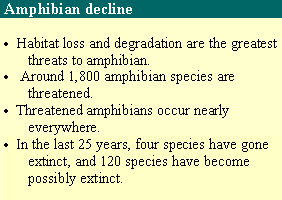
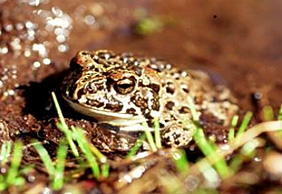
The Yosemite toad (Bufo canorus) is an endangered amphibian from the Sierra Nevada, California, USA. © 2004 Pierre Fidenci
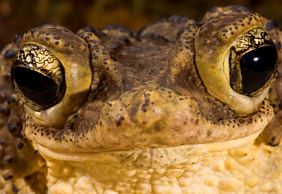
The critically endangered Puerto Rican crested toad (Bufo lemur) occupies mostly rocky limestone outcrops of Puerto Rico and the Virgin Gorda Island. © 2006 Paddy Ryan
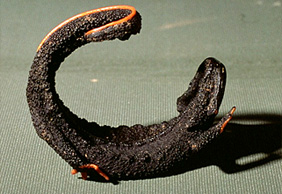
The critically endangered Chinhai salamander (Echinotriton chinhaiensis) lead a largely hidden terrestrial life. © 1999 Max Sparreboom
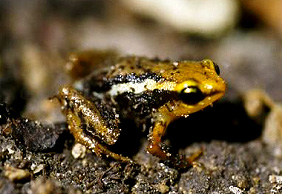
Rarely observed the critically endangered Baracoa dwarf frog (Eleutherodactylus orientalis) from Cuba is one of the smallest frog in the world. © 2004 Pierre Fidenci
Endangered amphibians worldwide |
|
Amphibians have existed on
earth for about 300 million years, yet within the last several decades
more than 120 species are thought to have disappeared for ever because
of human activities.
Amphibian populations have declined dramatically around the world since the 1950s even in virgin parts (e.g., national parks). This pervasive decline is the results of local, regional, and global human induced causes. In 2006, a total of 442, 738, and 631 amphibian species were classified as critically endangered (imminent risk of extinction), endangered (very high risk of extinction in the wild), and vulnerable (facing a high risk of extinction in the wild). Overall, 1 in 3 amphibians are at risk of extinction! Local impacts
These impacts include habitat modification,
amphibian collection, and non-native species introduction. Habitat
modification can be divided into three types: habitat destruction,
habitat fragmentation, and habitat degradation.
Regional impacts
These impacts include habitat modification,
amphibian collection, and non-native species introduction. Habitat
modification can be divided into three types: habitat destruction,
habitat fragmentation, and habitat degradation.
Global impacts
These impacts include environmental estrogens, climate change, and diseases (e.g. fungus Batrachochytrium dendrobatidis).
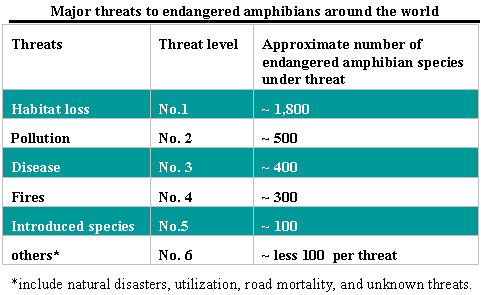
Data from IUCN, Conservation International, and NatureServe. 2006. Global Amphibian Assessment
Endangered amphibian species are found near all
over the planet (Table 2), however, some regions of the world have been
more affected than others. The worst places include Haiti, montane
southeastern Chiapas, Mexico through central Guatemala, montane Costa
Rica and western Panama, the Andes of Colombia and Ecuador, and the
central portion of the Atlantic Forest in eastern Brazil.
At the regional scale, amphibians in the Caribbean are most threatened (84% of the region’s 171 species) due to high habitat loss, followed by Mesoamerica (685 species) , South America (2,065 species), and North America (262 species). Countries with the highest number of threatened amphibians (more than 100 amphibians per country) include Colombia (209), Mexico (196), Ecuador (163), and Brazil (110). Distribution of Threatened Amphibians in Central America, Northern South America, and the Caribbean 
Data from IUCN, Conservation International, and NatureServe. 2006. Global Amphibian Assessment Table 2. Examples of worldwide critically endangered amphibians 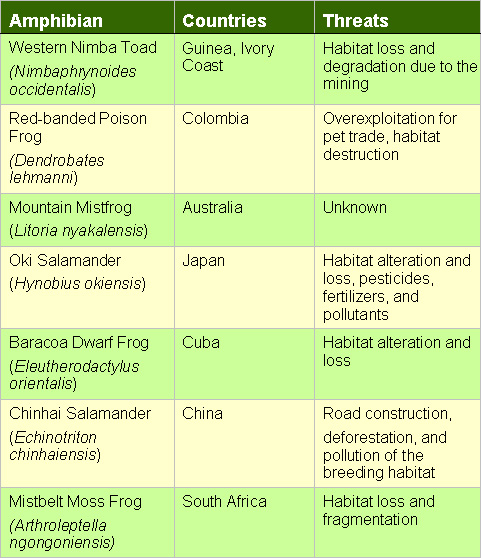
Data IUCN 2006
Here are nine of the most endangered species of
amphibians. Eight of the species are still being studied or bred in the
Center for Conservation and Research at Omaha's Henry Doorly Zoo &
Aquarium. One success, the eastern hellbender, has been released to the
wild, although some of them are on exhibit at the zoo.
The “at zoo” numbers are only for the Omaha zoo. The “in the wild” numbers are estimates from scientific counts.
Puerto Rican crested toad Native to: Puerto Rico Adult size: 3-4 inches Number in wild: 300 Number at zoo: 48 Loss of habitat has brought it close to extinction; it is critically endangered. Zoo is breeding them and has sent 11,000 tadpoles to Puerto Rico, but only 1 percent will become toads. 
Mississippi gopher frog Native to: Mississippi Adult size: 3 inches Number in wild: 60-100 Number at zoo: 303 Loss of habitat is its enemy. It has only one breeding pond in Mississippi. Zoo is testing Vitamin A as a nutritional supplement. 
Blue spotted salamander Native to: Iowa and states east and north of Iowa Adult size: 3½-5½ inches Number at zoo: 12 Doing well in eastern states but not Iowa. Attempts by the zoo to breed the Iowa salamanders in captivity failed; the zoo is working with Iowa Department of Natural Resources. 
Panamanian golden frog Native to: Panama Adult size: 2-3 inches Number in wild: 0 Number at zoo: 53 IUCN lists it as critically endangered. Zoo is having success breeding in captivity and is about to send some of its crop to other zoos. Can't release into the wild in Panama at this time. 
Kihansi spray toad Native to: Tanzania Adult size: 1-1½ inches Number in wild: 0 Number at zoo: 141 Habitat in waterfall spray zones has dried up. The zoo has created artifical spray zones and Tanzania is duplicating those. So if the toads will breed in captivity, they can be released in Tanzania. 
Utah Boreal toad Native to: one colony found on plateau Utah Adult size: 2-5 inches Number in wild: unknown Number at zoo: 23 The toad occupies 1 percent of its historic breeding places in Utah. The zoo has had some breeding success but chytrid fungus is its biggest danger. 
Wyoming toad Native to: Wyoming Adult size: 2 inches Number in wild: One small colony in protected area in Wyoming Number at zoo: 23 The zoo has released nearly 3,000 tadpoles and toadlets in Wyoming (remember 1 percent survival rate). The chytrid fungus remains a threat to its survival. 
Striped newt Native to: Two genetic groups native to Florida and Georgia Adult size: 2-4 inches Number in wild: unknown Number at zoo: 200 of one genetic group (eastern) Zoo has successfully bred its newts; the original 12 created 500. Western genetic group is smaller, more vulnerable. 
Eastern hellbender Native to: Ohio Adult size: 11½-20 inches Number in wild: unknown Number at zoo: 8 The salamander is successfully being bred in captivity and released into the wild. Chytrid fungus is a danger to it, along with siltation of habitat and chemical runoff in streams. |